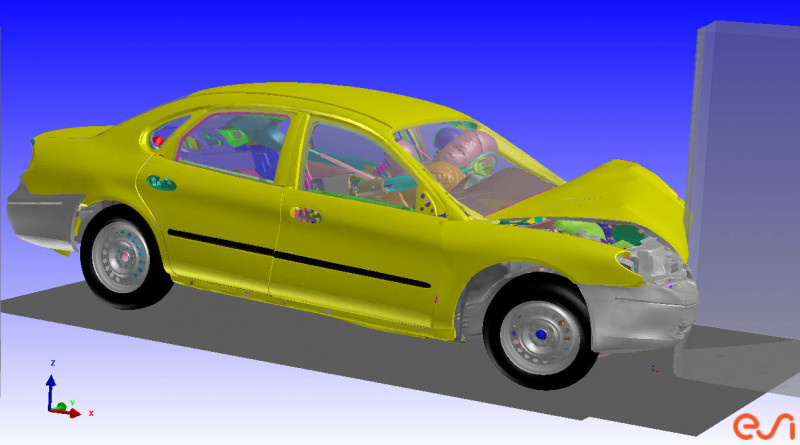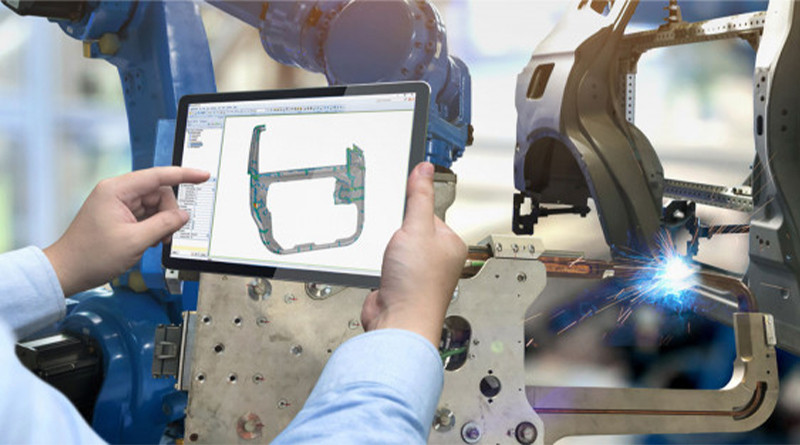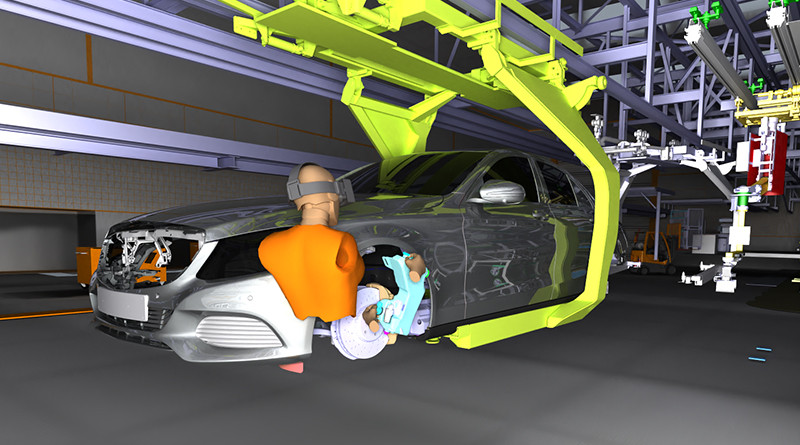How to Meet Industrial Digital Transformation Challenges With Virtual Prototyping Technologies
A CIMdata commentary on ESI’s predictive, real-time, & immersive virtual testing and how it supports the democratization of product & process simulation

Key Takeaways
- Simulation software primarily uses physics models to perform structural, thermal, and fluid-flow analyses, requiring deep domain expertise, and often expensive high-performance computers to get accurate results.
- Modeling effort and lengthy calculation times historically forced simulation off the critical path, impacting schedules, placing it in expert silos, and squandering broader opportunities that simulation can provide.
- Advances in simulation software, big data, machine learning, and computing hardware combined with a single logical source of truth mindset enable the means to test new designs before physical instantiation.
- Digital transformation commonly focuses on building a digital thread that unites the different product realization disciplines bringing simulation onto the critical path and ensuring that the right tradeoffs between accuracy and time-to-market are made.
- ESI's simulation software is built on three pillars: predictive, real-time, and immersive, thus enabling engineers to predict the performance of new designs easily, accurately, and quickly, paving the way for their customers' digital transformation.
When it comes to sustainable development practices, all roads lead to simulation software
Competitive pressures and corporate social responsibility commitments to more sustainable products and operations are driving companies across industries to broaden their use of simulation software. Advances in simulation technology are enabling companies to increasingly rely on numerical reference results from virtual prototypes rather than physical testing of hardware prototypes.1
Digital transformation programs are using advanced simulation software capabilities and faster computing to speed and improve processes while connecting digital threads ensuring end-to-end traceability and better information reuse. Technology advances such as simulation democratization and High-Performance Computing (HPC) in combination with cloud services are enabling digital transformation via the incorporation of simulation software and processes within the digital thread. By creating virtual products and manufacturing processes, enterprises can test products and manufacturing processes before they are physically instantiated dramatically shortening timelines, reducing cost, and improving quality.

HPC and software performance advances are enabling fast, even real-time simulation with high data accuracy to support design exploration and manufacturing process validation, ensuring product and process requirements are properly verified and validated. Interactive modeling and advanced user interfaces (UX) such as augmented reality/virtual reality (AR/VR) to display interactive, dynamic, immersive results within the context of the human (worker, operator). This enables simulated interaction with the product and its operating environment, for example, product development teams can predict performance and maintenance teams can predict maintenance requirements and simulate maintenance events.
CIMdata clients are incorporating simulation more broadly and deeply as part of their digital transformation strategies resulting in the ability to make better decisions across the lifecycle, leading to improved product launches, better products, happier customers, and better business performance.
Virtually replicate product development, testing, and manufacturing in the automotive, aerospace, energy, and heavy equipment industries
ESI Group is celebrating 50 years of supplying simulation software solutions and partnering with industry leaders in leveraging their combinatorial digital simulation technologies to meet their customers' ambitious goals on their 'Mission Zero' journey towards greater sustainability. Headquartered in France, ESI operates globally in 20 countries and has expanded over the decades to provide a broad suite of solutions supporting the automotive, aerospace, energy, and heavy equipment industries.
At its center, ESI’s product portfolio is integrated within three core business lines to virtually replicate product development, testing, and manufacturing with predictive physics-based modeling and simulation:
- Product Performance—Perform virtual testing and validate product performance, such as crash & safety; noise, vibration, & harshness (NVH); acoustics; and system performance.
- Smart Manufacturing—Links single process activities such as stamping, casting, and composite manufacturing to the welding and assembly processes to build a complete virtual manufacturing process chain.
- Human Centric Process Validation and Product Integration—Virtual reality and immersive experiences focused on product integration, assembly line, and service process validation.
ESI sees its core differentiator as its ability to predict a wide variety of physics phenomena quickly, easily, and effectively while fully supporting customers’ digital threads from design through production by chaining processes and physics.
Product Performance
ESI’s Product Performance business line links well with its long history in structural simulation and automotive crash simulation. Additionally, its business line supports simulation domains such as safety and acoustic performance, as well as noise, vibration, and harshness (NVH), which are key areas for its customers. The ability to reuse data, chain solutions together, and have iterations happen simultaneously across all simulation domains improves productivity while promoting a single source of truth approach.

A Frontal Crash in Virtual Performance Solution (VPS) Simulation
As new safety certification regulations emerge, ESI is primed to respond to those extended market requirements with the release of new offerings, such as the new weld rupture offering and the soon-to-be-released software for advanced model-order reduction for crash simulation. Companies can create reduced order models that work in the context of their requirements and processes. With reduced order modeling, engineers can package simulation models that support real-time design/solution space exploration. This way they can analyze iterations quickly and make better decisions faster. This is important as it enables simulations to be on the critical path without slowing time-to-market.
Smart Manufacturing
Simulation has been used in manufacturing engineering for decades, supporting early simulations of single-part manufacturing processes like sheet metal forming, casting, and composites - and ESI has been proudly supporting its partners in all three of these processes for decades. Beyond this, the chaining of part/welding simulation results with performance engineering facilitates concurrent engineering, for instance, to validate crash and safety, while the chaining of part manufacturing simulation with welding assembly simulation ultimately enables an end-to-end virtual manufacturing process.

Therewith, the final product can then be virtually evaluated “as manufactured” while pushing the efficient parallelization of workflows between product and manufacturing engineering throughout the development process.
This holistic approach aims at securing an early and reliable assessment of the manufacturing quality of the assembled product, leading to fewer recalls, and greater customer satisfaction at lower cost and shorter time-to-market. In parallel, this approach establishes more sustainable practices by reducing the number of physical prototypes—reducing waste, natural resources, and emissions while helping to meet regulatory requirements.
Human Centric Process Validation and Product Integration
As presented at the NVIDIA GTC Conference2 last year, ESI is working on extending the capabilities of its Virtual Reality software with new collaborative virtual workspace features. This will further democratize the use of VR and simulation technology and bring it to a broader audience of enterprise customers that need to validate product integration, assembly, and maintenance processes.

In support of this offering, ESI also announced that it is committed to further integrating itself into its customers’ digital threads and PLM ecosystems by working with PTC to provide an initial integration between ESI’s virtual reality software IC.IDO and PTC’s Windchill PLM solution. CIMdata is excited to continue following this collaboration and talking to customers about their experiences as the solution rolls out.
The future of simulation and the digital thread
We are entering a golden age of product development. The latest generation of solutions combined with a properly designed digital thread is enabling practically sci-fi-level capabilities. We’ve come a long way from hand-coded FEA meshes to now working with virtual reality and the metaverse and ESI has participated in every step along the way. ESI’s three key differentiators include:
- Predictive virtual prototyping to model products and manufacturing processes.
- Real-time decision-making enabled by advanced software, HPCs, and reduced order modeling.
- Human-centric solutions that provide advanced immersive capabilities to support virtual exploration and validation of products and processes while enabling efficient collaboration.
CIMdata has followed ESI for many years and is continually impressed by its vision and focus. They understand the needs of their chosen industries and offer proven virtual prototyping solutions. From virtual testing to in-scenario simulation—the latest generation of solutions are exciting and most importantly, provide great value to their customers by improving productivity and enabling safer more sustainable products to be created. If you are a manufacturer and want to improve your performance by leveraging advanced and easy-to-use simulation technology, connect with the team over at ESI. For more info on ESI’s VR offerings, check out their latest publication titled “A Virtual Reality Software E-Book for the Aerospace Industry.”3
1 Research for this commentary was partially supported by ESI
2 https://www.esi-group.com/events/2022/gtc-2022-the-developer-conference-for-the-era-of-ai
3 https://www.esi-group.com/a-virtual-reality-software-e-book-for-the-aerospace-industry
About CIMdata
CIMdata, an independent worldwide firm, provides strategic management consulting to maximize an enterprise’s ability to design, deliver, and support innovative products and services by identifying and implementing appropriate digital initiatives. For nearly forty years, CIMdata has provided industrial organizations and providers of technologies and services with world-class knowledge, expertise, and best-practice methods on a broad set of product lifecycle management (PLM) solutions and the digital transformation they enable. CIMdata also offers research, subscription services, publications, and education through certificate programs and international conferences. To learn more, visit www.CIMdata.com or email info [at] CIMdata.com.
Tom Gill has over 25 years of experience applying computer-based solutions to engineering and manufacturing. Before joining CIMdata he worked as an independent PLM consultant, after spending over 20 years at high-volume manufacturing companies.
At CIMdata, Mr. Gill has worked on projects in numerous industries, including fabrication & assembly, food & beverage, defense, chemical, and medical devices. He has executed PLM strategy projects, solution evaluation-and-selection projects, deployment planning, and training development for industrial clients. He delivers solution providers competitive and technical product analyses, white papers, and case studies. He has presented papers both nationally and internationally.
Mr. Gill holds a BS in Mechanical Engineering from the University of Maine and is Configuration Management certified.